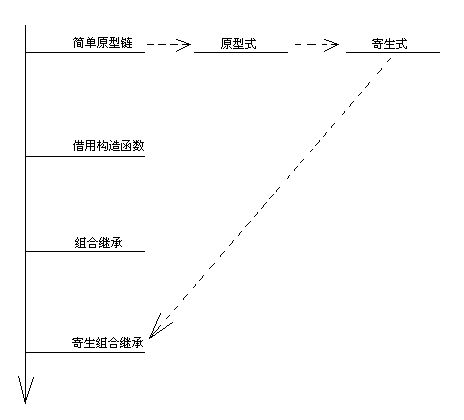1. 简单原型链继承
function Animal(){this.name = '动物';this.skill = [1];}function Cat(){this.age = '13';}Cat.prototype = new Animal(); // 核心(拿父类实例充当子类的原型对象)var amyCat = new Cat();var tomCat = new Cat();amyCat.skill.push(2);console.dir(Animal);console.dir(Cat);console.log(amyCat.name);console.log(tomCat.skill);console.log(amyCat.skill);// 优点// 简单易于实现。// 存在问题// 1.原型对象的引用属性是所有实例共享的。// 2.创建子类实例时,无法向父类构造函数传参。
2. 借用构造函数
function Animal(name){this.name = name;this.skill = [1];this.fun = function(){};}function Cat(name,age){// Animal.call(this,name); // 核心Animal.apply(this,[name]); // 此处区分了call和apply的区别,apply用的是数组参数。this.age = age;}var smallCat = new Cat('small Cat',12);var bigCat = new Cat('Big Cat', 15);smallCat.skill.push(2);console.dir(smallCat);console.dir(bigCat);console.log(smallCat.name);console.log(bigCat.name);console.log(bigCat.skill);// 核心// 借用父类构造函数来增强子类的实例,等于将父类的实例属性复制一份到子类实例中,没有用到原型。// 优点// 1. 解决了子类实例共享父类引用属性的问题。// 2. 创建子类实例时,可以向父类构造函数传参。// 缺点// 1. 无法实现函数复用,每个子类实例都持有一个新的fun函数,太多会影响性能。
3. 组合继承(组合继承)
function Animal(name){this.name = name;this.skill = [1];// this.fun = function(){};}Animal.prototype.fun = function(){console.log(this.name);};function Cat(name,age){Animal.call(this, name); // 核心this.age = age;}Cat.prototype = new Animal(); // 核心var cat1 = new Cat('asdf', 10);var cat2 = new Cat('xxx', 23);console.dir(cat1);console.dir(cat2);cat1.fun();cat2.fun();// 核心// 将实例函数放在原型对象上,来实现函数复用。同时保留借用构造函数方式的优点。// Animal.call(this, name); 继承父类的基本属性,并且向父类构造函数传参。// Cat.prototype = new Animal(); 继承父类函数,实现函数复用。// 优点// 1.不存在引用属性(函数等)共享的问题。// 2.可传参。// 3.函数可复用。// 缺点// 1.子类原型上有一份多余的父类实例属性,因为父类构造函数被调用了两次,// 子类实例上的属性屏蔽了子类原型上的属性,造成内存浪费。
4. 寄生组合继承(最佳方式)
function beget(obj){var F = function(){};F.prototype = obj;return new F();}function Animal(name){this.name = name;this.skill = [1];}Animal.prototype.fun1 = function(){console.log(1);};Animal.prototype.fun2 = function(){};function Cat(name,age){Animal.call(this,name); // 核心this.age = age;}var proto = beget(Animal.prototype); // 核心proto.constructor = Cat; // 核心Cat.prototype = proto; // 核心var cat1 = new Cat();console.dir(Cat);console.dir(cat1);cat1.fun1();// 核心// beget(Animal.prototype)。去掉了原型对象上多余的父类实例属性。// 优点:包括上述3中方式的优点。// 缺点:(据说组合继承是比较常用的。)
5. 原型式继承
function beget(obj){var F = function(){};F.prototype = obj;return new F();}function Animal(name){this.name = name;this.skill = [1];}Animal.prototype.fun1 = function(){};var animal = new Animal('animal xxx');var cat = beget(animal);cat.age = 123;console.dir(cat);console.log(cat.age);// 核心// 使用beget函数得到一个新对象(无实例属性),再逐步增强(填充实例属性)。// ES5提供了Object.create()函数,内部就是原型式继承。IE9+支持。// 优点:// 从已有对象衍生新的对象,不需要创建自定义类型。// 缺点:// 1. 原型继承引用属性会被所有实例共享,因为用整个父类对象来充当子类原型对象,所以会有这个缺陷。// 2. 无法实现函数复用。(属性现添的)
5. 寄生式(是一种模式,并不只能用来实现继承)
function beget(obj){var F = function(){};F.prototype = obj;return new F();}function Animal(name){this.name = name;this.skill = [1];}Animal.prototype.fun1 = function(){};function getSubObject(obj){// 创建新对象var clone = beget(obj); // 核心// 增强clone.age = 1;return clone;}var sub = getSubObject(new Animal('zfd'));console.dir(sub);console.log(sub.name);console.log(sub.age);// 核心// 给原型式继承穿个马甲。(上面的原型继承更像是对象复制,等下写写对象复制。)// beget()函数不是必须的,创建新对象->增强->返回该对象,这样的过程叫 寄生式继承,// 新对象如何创建的并不重要(beget生的,new出来的,字面量都可以)。// 优点:// 不要创建自定义类型(不用写子类构造函数吗)// 缺点:// 无法实现函数复用(没有用到原型,所以不行)// ------寄生式继承+组合继承 = 寄生组合式继承。
6种继承方式的联系

P.S.虚线表示辅助作用,实线表示决定性作用

